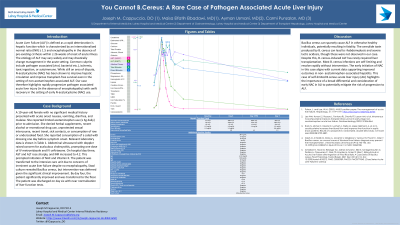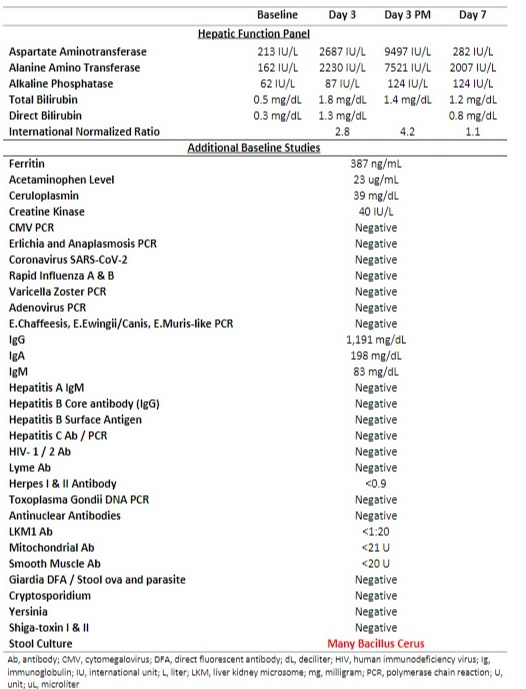Monday Poster Session
Category: Liver
P2574 - You Cannot B.cereus: A Rare Case of Pathogen Associated Acute Liver Injury
Monday, October 23, 2023
10:30 AM - 4:15 PM PT
Location: Exhibit Hall

Has Audio

Joseph Cappuccio, DO
Lahey Hospital and Medical Center
Burlington, MA
Presenting Author(s)
Joseph Cappuccio, DO, Ayman Usmani, MD, Maisa Elbadawi, MD, Carmi Punzalan, MD
Lahey Hospital and Medical Center, Burlington, MA
Introduction: Acute liver failure (ALF) is the rapid deterioration of hepatic function, characterized by an international normalized ratio (INR) ≥ 1.5 and encephalopathy within 26 weeks of acute illness without pre-existing liver disease. The etiology of ALF can vary widely. N-acetylcysteine (NAC) is thought to improve hepatic circulation and transplant-free survival even in non-acetaminophen-related ALF. Our case describes rapidly progressive pathogen-associated acute liver injury and swift recovery with early NAC administration.
Case Description/Methods: A 19-year-old female with no significant medical history presented with acute onset nausea, vomiting, diarrhea, and malaise. She reported limited acetaminophen use (< 3g daily) prior to admission. She denied herbal supplements, recent alcohol or recreational drug use, unprotected sexual intercourse, recent travel, sick contacts, or consumption of raw or undercooked food. She reported consumption of a salad with dressing one day before symptom onset. Relevant laboratory data is shown in Table 1. Abdominal ultrasound with doppler raised concern for acalculous cholecystitis, prompting one dose of IV metronidazole and IV ceftriaxone. On hospital day three, AST and ALT rose sharply, and INR increased to 4.2. This prompted initiation of NAC and Vitamin K. The patient was transferred to the intensive care unit due to concerns of imminent acute liver failure despite no encephalopathy. Stool culture revealed Bacillus cereus, but intervention was deferred given the significant clinical improvement. By day four, the patient significantly improved and was transferred to the floor. The patient was discharged on day six with near normalization of liver function tests.
Discussion: Bacillus cereus can sparsely cause ALF in otherwise healthy individuals, potentially resulting in fatality. The cereulide toxin produced by B. cereus can lead to rhabdomyolysis and severe lactic acidosis, though these were not observed in our case. Despite this, B. cereus-induced ALF has rarely required liver transplantation. Most B. cereus infections are self-limiting and resolve rapidly without intervention. The early initiation of NAC in this case aligns with current data supporting improved outcomes in non-acetaminophen-associated hepatitis. This case of self-limited B.cerus acute liver injury (ALI) highlights the importance of a broad differential and consideration of early NAC in ALI to potentially mitigate the risk of progression to ALF.

Disclosures:
Joseph Cappuccio, DO, Ayman Usmani, MD, Maisa Elbadawi, MD, Carmi Punzalan, MD. P2574 - You Cannot B.cereus: A Rare Case of Pathogen Associated Acute Liver Injury, ACG 2023 Annual Scientific Meeting Abstracts. Vancouver, BC, Canada: American College of Gastroenterology.
Lahey Hospital and Medical Center, Burlington, MA
Introduction: Acute liver failure (ALF) is the rapid deterioration of hepatic function, characterized by an international normalized ratio (INR) ≥ 1.5 and encephalopathy within 26 weeks of acute illness without pre-existing liver disease. The etiology of ALF can vary widely. N-acetylcysteine (NAC) is thought to improve hepatic circulation and transplant-free survival even in non-acetaminophen-related ALF. Our case describes rapidly progressive pathogen-associated acute liver injury and swift recovery with early NAC administration.
Case Description/Methods: A 19-year-old female with no significant medical history presented with acute onset nausea, vomiting, diarrhea, and malaise. She reported limited acetaminophen use (< 3g daily) prior to admission. She denied herbal supplements, recent alcohol or recreational drug use, unprotected sexual intercourse, recent travel, sick contacts, or consumption of raw or undercooked food. She reported consumption of a salad with dressing one day before symptom onset. Relevant laboratory data is shown in Table 1. Abdominal ultrasound with doppler raised concern for acalculous cholecystitis, prompting one dose of IV metronidazole and IV ceftriaxone. On hospital day three, AST and ALT rose sharply, and INR increased to 4.2. This prompted initiation of NAC and Vitamin K. The patient was transferred to the intensive care unit due to concerns of imminent acute liver failure despite no encephalopathy. Stool culture revealed Bacillus cereus, but intervention was deferred given the significant clinical improvement. By day four, the patient significantly improved and was transferred to the floor. The patient was discharged on day six with near normalization of liver function tests.
Discussion: Bacillus cereus can sparsely cause ALF in otherwise healthy individuals, potentially resulting in fatality. The cereulide toxin produced by B. cereus can lead to rhabdomyolysis and severe lactic acidosis, though these were not observed in our case. Despite this, B. cereus-induced ALF has rarely required liver transplantation. Most B. cereus infections are self-limiting and resolve rapidly without intervention. The early initiation of NAC in this case aligns with current data supporting improved outcomes in non-acetaminophen-associated hepatitis. This case of self-limited B.cerus acute liver injury (ALI) highlights the importance of a broad differential and consideration of early NAC in ALI to potentially mitigate the risk of progression to ALF.

Figure: Table 1: Laboratory and Additional Clinical Data
Disclosures:
Joseph Cappuccio indicated no relevant financial relationships.
Ayman Usmani indicated no relevant financial relationships.
Maisa Elbadawi indicated no relevant financial relationships.
Carmi Punzalan indicated no relevant financial relationships.
Joseph Cappuccio, DO, Ayman Usmani, MD, Maisa Elbadawi, MD, Carmi Punzalan, MD. P2574 - You Cannot B.cereus: A Rare Case of Pathogen Associated Acute Liver Injury, ACG 2023 Annual Scientific Meeting Abstracts. Vancouver, BC, Canada: American College of Gastroenterology.
